With the rate that ski gear is advancing, it can be hard to keep track of the latest space-age fiber blends and non-traditional rocker profiles. That’s where this Gear Guide comes in. Our editors spent their summer studying the newest features and technologies found in skis, boots and bindings. Then, they spent just as much time poring over our gear testers’ handwritten forms. These sprawling scribbles were made on chairlifts, in ski lodges and during the bus ride between the mountain and the condos. Between beer and coffee stains, testers’ notes tell us how these products work. Does the milled wood core flex as intended? Are the carbon stringers too stiff or just stiff enough? Is the walk mode actually 75 degrees, or does the lower shell cutout get in the way? In our reviews, we breakdown the latest tech and combine it with the unbiased tester feedback so you can find your perfect match. —The Editors
Salomon Shift Supra Boa 105 W
3,620g | Flex: 105 | ROM: 55° | Last: 100mm | Available Sizes: 22-27.5 | salomon.com
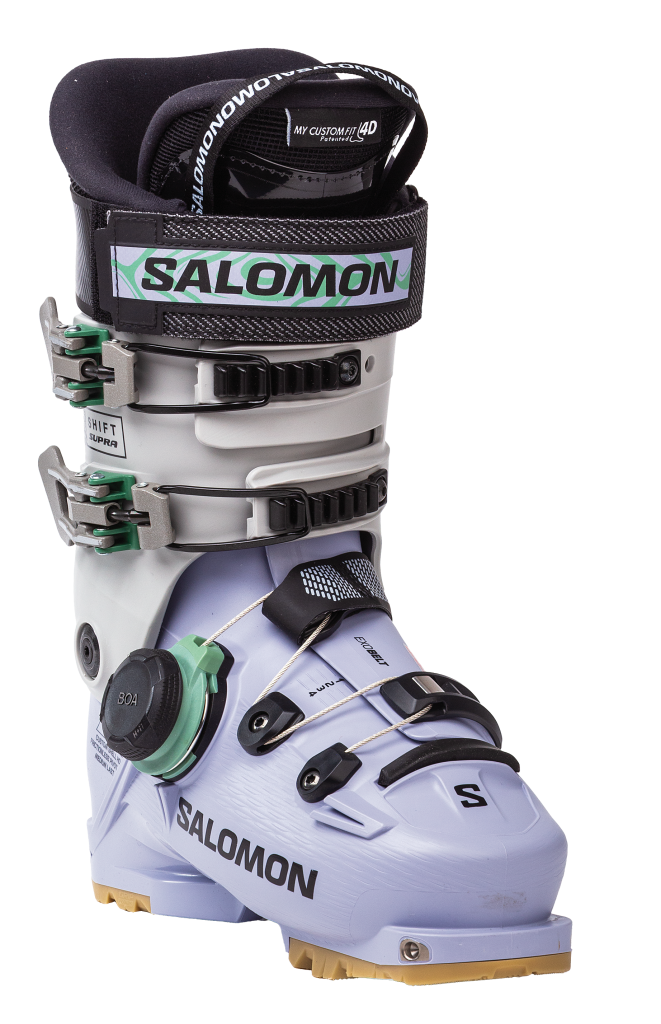
Last year, we met Salomon’s new Shift Alpha Boa boots. This year, meet the Alpha’s wider-last sibling line: the Supra, with a claimed last of 100-106 across models. Testers reported a midwidth volume (4/7 on a scale from narrow to wide), meaning the 105 W housed some happy feet. Instant comfort came from Salomon’s adjustable tongued liner. As one Vermonter said, “Everyone dreads first days in a new boot, but these boots were gateways to fun out of the box.” Though a seasoned boot tester from Colorado found the Supra held her arch in place well, she caveated, “pinches a non-narrow foot.”
The Supra features a polyurethane shell and a polyolefin cuff. A beefy Boa secures the boot with help from the Exobelt—a rubber strap that links to the wire opposite the Boa knob—and tick marks along the top of the foot aid in even adjustments, which our Coloradan appreciated. Two buckles and a power strap secure the cuff. Our suite of testers scored the Supra Boa 5/7 for fore/aft and lateral stiffness. “The Supras deliver power directly to the ski’s edge without any energy loss,” said the seasoned Coloradan. “I was able to progressively flex in these without feeling restricted,” added a Californian rookie with a race background.
That Californian recommended these boots for a 65 resort/35 backcountry lifestyle, saying, “Walk mode doesn’t allow for the most room but enough to comfortably uphill.” A college Nordic racer found the mechanism operated smoothly, but testers agreed the claimed 55-degree ROM wasn’t ideal for longer tours. Summed up our rookie, “If you are looking for high-performance boots, these are them.”
“Great for a strong intermediate skier who wants a boot with pins that skis like an alpine boot.” —Maggie McGee
Scott Hint 130 GW Boot
3,580g | Flex: 130 | ROM: 55° | Last: 99mm | Available Sizes: 23.5-30.5 | scott-sports.com
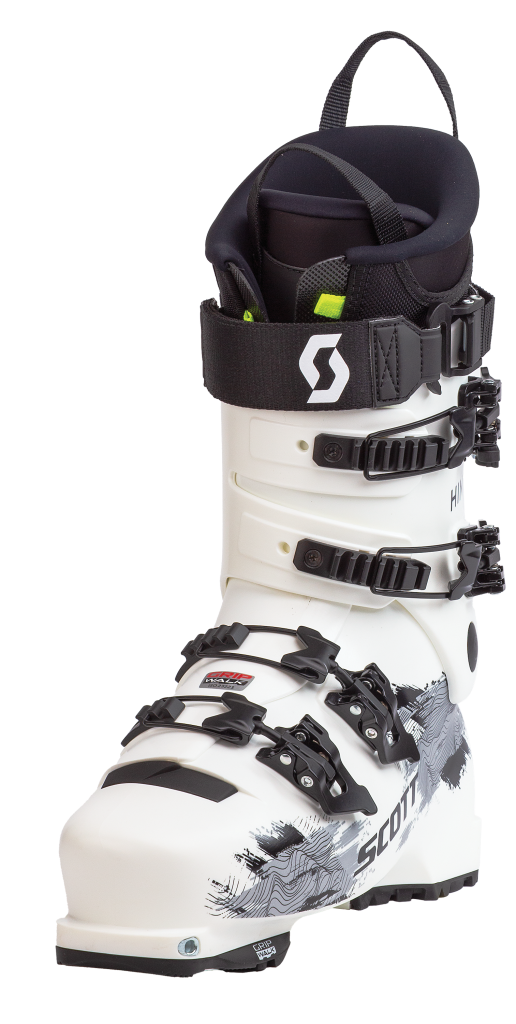
The Scott Hint 130—originally a Fischer design—is a fully fledged freeride boot that can walk, if asked politely. “Purpose-built for banging out sidecountry/resort laps,” said an OG boot tester after ripping, you guessed it, sidecountry and resort laps.
A departure from Scott’s typically wide fit, the Hint 130’s 99-millimeter last was a relief for the narrow-footed and still impressed fat-footed testers. “This boot was too small for my sasquatch feet and was still my favorite of the lineup to ski,” proclaimed a Vermonter tall enough to be mistaken for bigfoot. A fully polyurethane construction, overlap shell, 16-degree forward lean and GripWalk sole make the Hint reminiscent of an alpine boot. “For someone who wants an aggressive, stiff boot to ski hard and is willing to sacrifice a bit of weight,” explained the sasquatch impersonator. Two other 6-foot-plus men countered the claims of race-ready stiffness. “Flex was progressive but overall, somewhat soft despite being touted as 130,” said one, who still gave fore/aft and lateral stiffness a 6/7 score on the whole. “There’s a hint it’s definitely not a 130 flex,” agreed an Ice Coast judge.
The judge did give his stamp of approval for unexpected touring chops. “The simplest walk-mode lever ever and a decent range of motion,” he said of the claimed 55-degree ROM. To transition to walk mode, a switch below the top buckle opens up the cuff. “I was pessimistic, but the walk-mode lever just below the uppermost cuff allowed easy operation through my ski pant with a gloved hand,” explained the OG Coloradan. However, he still recommended the Hint for mostly inbounds use.
“Short list candidate for the skier who only wants one boot for 70% lift-served/30% short touring.” —Shaggy Bailey
Scarpa Quattro GT
3,300g | Flex: 110 | 61° | Last: 101mm | Available Sizes: 24.5-32 | scarpa.com

Since the Quattro line debuted in the ’22/23 season, some version of Scarpa’s four-buckled boot has won Editors’ Choice each year. This year, the Quattro GT impressed testers most with its touched-up comfort added to the now expected performance of the Quattro line.
The GT adds higher volume—including an extra 1 millimeter of last—a warmer Intuition liner than its line mates and a multilayer footbed to the boot’s tried-and-true formula. The resulting comfort led a Crested Butte local to proclaim, “I’d walk all day in these!” The GT also sports a softer, more forgiving flex than Scarpa’s previous EC-winning XT and Pro models due to a fully polyurethane cuff and shell. The closure mechanism remains unchanged, with four buckles and a power strap locking down an Alpine Axial Hybrid cuff—essentially an overlap tongue that cinches down when tightened to increase power transfer. When locked down, the boot offers 17 degrees of forward lean with 2 degrees of adjustability. “Maintains a lot of the touring performance of the other Quattros but softer and easier to ski,” explained a Vermonter who’s skied every version of the boot. He added the lack of carbon reinforcement made the boot “seem damper as well.”
On the ascent, the simple walk-mode lever was “easy to adjust with gloves on,” per the Coloradan. The carried-over walk mode allows for a claimed 61-degree range of motion. “Good walk mode and free pivot,” praised a Nordic coach who prefers boots that walk like his classic-skiing slippers. Paired with the softer flex, that coach recommended the GT as a perfect “entry-level backcountry 50/50 boot.”
“A boot of one for the universal skier.” —Gavin Cooper
Atomic Backland XTD Carbon 120
2,760g | Flex: 120 | ROM: 74° | Last: 100mm | Available Sizes: 24-30.5 | atomic.com
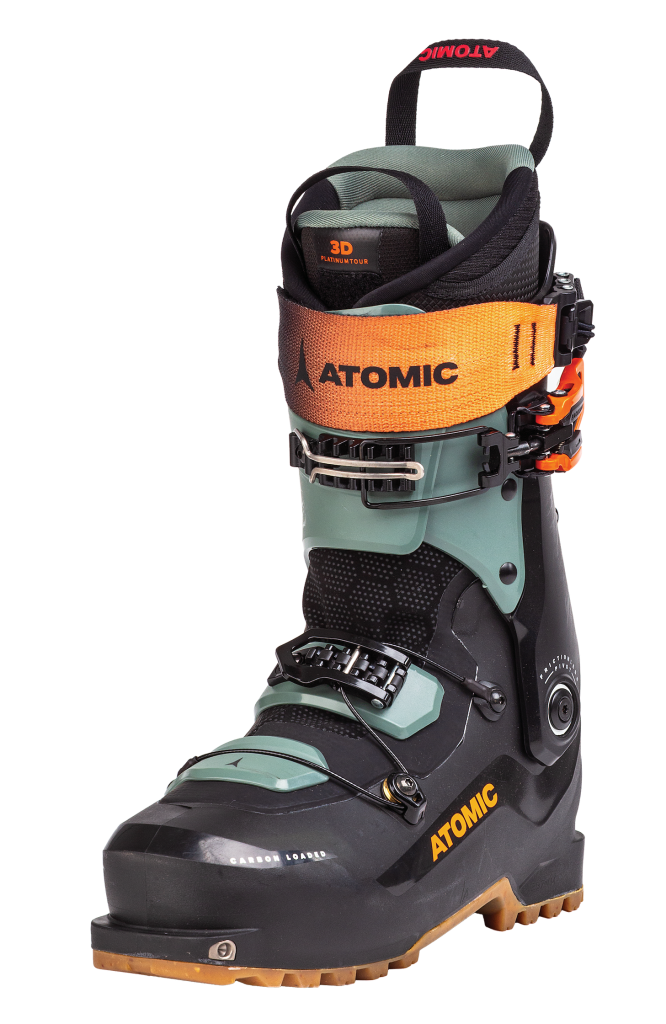
In a world of complicated buckles resembling mouse traps, the Backland XTD stands out. “The buckles are simple, which seems like a silly thing to say for a notable feature, but it seems that more and more buckles are becoming overly complicated,” said a boot tester of the power strap, cuff buckle and z-cord over the forefoot.
The buckles are a plus, but they weren’t the only thing that stood out. Testers praised the progressive flex, thanks to the carbon-infused polyamide cuff and shell and carbon-reinforced spine. While testers gave an average score of 5/7 for fore/aft and lateral stiffness, one had mixed feelings. “Progressive flex but seems softer than the purported 120 flex,” he explained. Just below the cuff buckle and over the ankle is a gaiter-covered cutout that allows for a 74-degree range of motion when in walk mode. Our tester who questioned the flex had no qualms here. “Craves long walkabouts in the backcountry,” he said. A Vermont Nordic coach added, “The walk mode is good, and the shape of the boot was comfortable and would accommodate a long day of foot swell in the skintrack.” The rest of our testers agreed on the comfort, scoring the liner quality as a 5/7.
While the buckles and walk mode itself were universally loved, testers questioned the walk mode lever. “The winky, long tour lever isn’t super friendly to operate with a gloved hand,” said a longtime tester who worried about durability and icing issues.
“This is a ripping little AT boot that packs a big punch.” —Shaggy Bailey
La Sportiva Sender W
2,650g | Flex: 130 | ROM: 64° | Last: 102.5mm | Available Sizes: 23-27.5 | lasportivausa.com
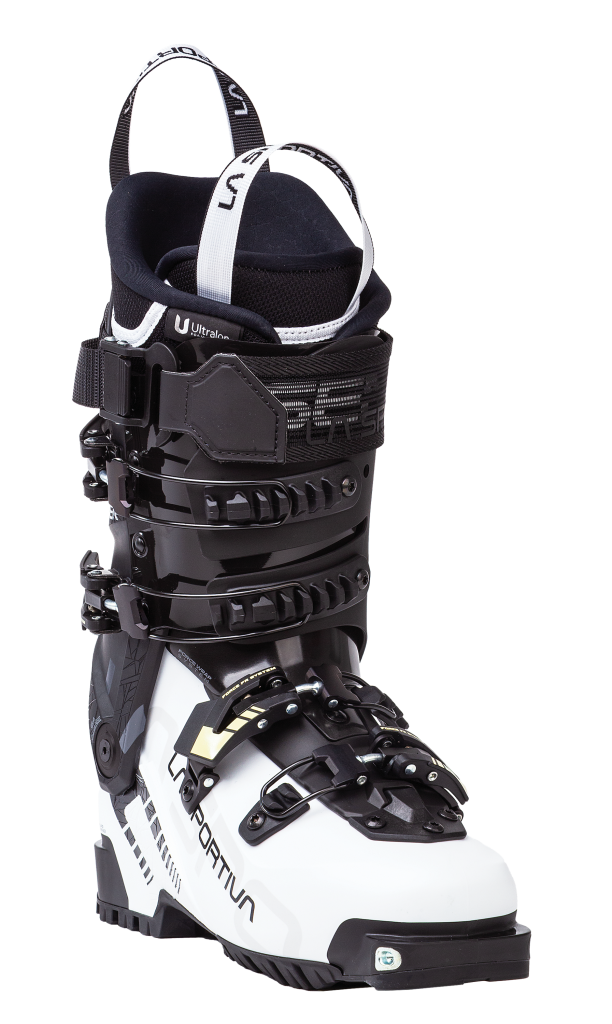
“Might just be my unicorn boot of the test,” said a well-versed boot tester from the Rockies. She went on to list everything from its light weight to its buckles as reasons why La Sportiva’s new-this-year Sender W is the ski boot equivalent of a magical, horned horse. “Would work well for anyone looking to go for longer walks while maintaining downhill performance,” added a seasoned, Wasatch-based tester.
The 105-flex boot sports a fiberglass cuff, a pebax shell and tongue derived from castor oil, a fiberglass shell cover (stabilizes the top of the foot) and La Sportiva’s Force Wrap System (a panel of Pebax Rnew which supports the front of the cuff). Four technopolymer (ultra-light) buckles and a power strap lock it all in. While the materials did their job—our three veteran boot testers’ gave an average 6/7 score for fore/aft and lateral stiffness—it was the ability to choose between two forward lean positions (12 and 14 degrees) that really enchanted them. The cuff, which two noted as taller and more akin to an alpine boot, earned praise, too. “The cuff and forward lean adjustment are perfect, and this boot can ski most expert slopes,” said a Tahoean. Our Coloradan agreed and added that the buckles, which close the opposite way across the forefoot kept her ankle particularly stable.
On the uphill, the Sender offers a claimed 64-degree ROM. “Love the simple walk mode,” our Wasatch ripper said. “Good range.” Her only advice: swap in a ZipFit liner.
“This boot works well as a lighter in-between ski boot that would thrive in an 80/20 split between inbounds/touring.” —Jocelyn Cuthbert
Tecnica Zero G Tour Pro
2,560g | Flex: 130 | ROM: 65° | Last: 99mm | Available Sizes: 22.5-30.5 | blizzard-tecnica.com
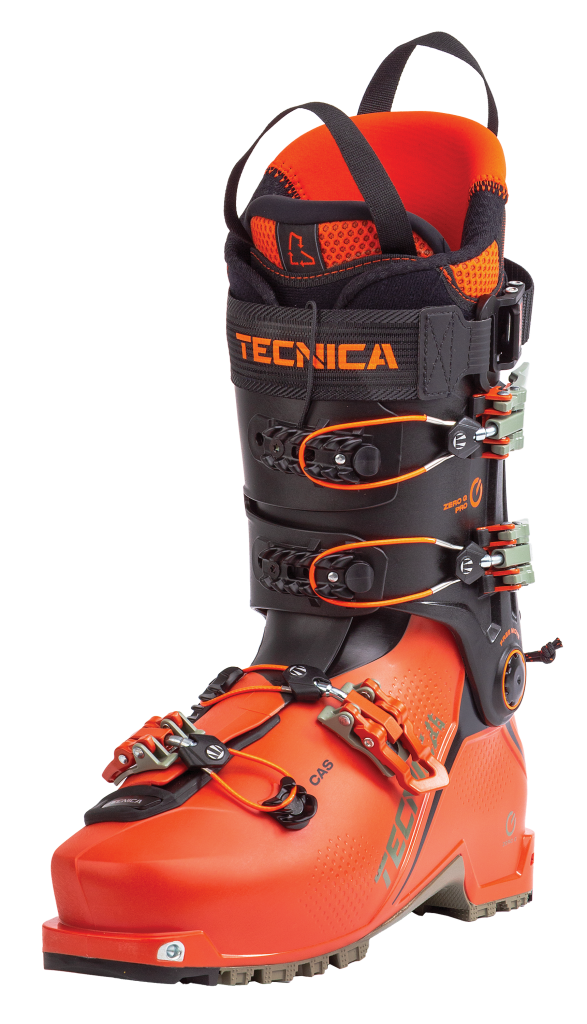
The Zero G Pro Tour returned unchanged from last year’s EC-winning design and continued to impress testers, who awarded it a 6/7 overall score. “It strikes an ideal balance between long walks and still having the power for confident skiing in all conditions,” said a big mountain backcountry slayer with a ski racing background.
The Zero G Pro Tour uses co-injected bands of grilamid in the front and carbon in the back of the grilamid shell. These bands, dubbed the Power Frame, connect the ankle pivot point to the T-Hike walk-mode’s three connection points: one on the lower shell and two on the upper cuff for a more progressive flex. “Grilamid shell with carbon fiber to keep it stiff and light. The forward lean, up to 16 degrees, is significant, and, with its 130 flex, the boot naturally keeps you in a dynamic skiing position,” said a freeride coach. Our former racer added, “This boot has pushed what a 1,250-gram boot can do and has found a weight so low that if they lighten it any more it wouldn’t have the damping ability for a boot in its class.”
Testers found the walk-mode lever easy to reach and gave a 6/7 for stride length. “Extra hook on walk mode buckle keeps it from unexpectedly releasing,” said a hard charger. “For long touring days or going out of the resort, this boot does it all. Impressive liner. Light buckles and an incredible walk mode,” added a Montana-based tester. A boot fitter noted that the wider forefoot and taller instep made it a more universal fit, concluding, “Folks, we have a winner.”
“A powerful ski boot for inbounds and out. A boot with no compromise.” —Ethan Jeanette
Scarpa F1 XT
2,290g | Flex: 95 | ROM: 72° | Last: 100mm | Available Sizes: 23-31 | scarpa.com

Scarpa’s been evolving ski boots since 1970, and the two-time Editors’ Choice winning F1 XT proves natural selection works. “Can I steal these?” questioned a tester who’s steadfastly refused to accept anything other than a four-buckle boot.
A light-yet-stiff carbon-infused grilamid cuff carries over from the earlier F1 LT and pairs with a grilamid and fiberglass shell from the F1 GT. A gaiter Velcroed to the tongue keeps out snow. The shell closes via Scarpa’s WaveLite closure system, a Z-shaped cable that locks down via a single buckle. A large power strap bolsters flex and stiffness. “You can actually push into the cuff a bit without hitting a brick wall,” confirmed one tester, although he noted they punished backseat driving. For those in the front seat a stock 13-degree forward lean also feels “slightly more forward than similar boots,” per a lightweight boot connoisseur.
Some found the thermo-moldable Intuition liner improved downhill chops; others weren’t impressed by comfort. “A burlier Intuition liner helps distribute shin pressure and keeps the boot from deforming,” said one believer, although he added, “Fit is on the narrow side of medium volume.”
For all the downhill performance, the F1 XT shined brightest on the skintrack. A 72-degree ROM engages easily via a large lever on the heel and pairs with some room around the ankle. “This boot craves uphill,” said a collegiate racer used to plug boots. “The mobility in walk mode is crazy!” A couloir hunter agreed: “Best for long walks or someone wanting a reliable yet light boot to pair with lighter skis.”
“The best stiff, lightweight, huge ROM boot out there with a flex you can actually ski.” —Liam McGee
Dynafit Ridge W
2,300g | Flex: 100 | ROM: 70° | Last: 101mm | Available Sizes: 23-27.5 | dynafit.com
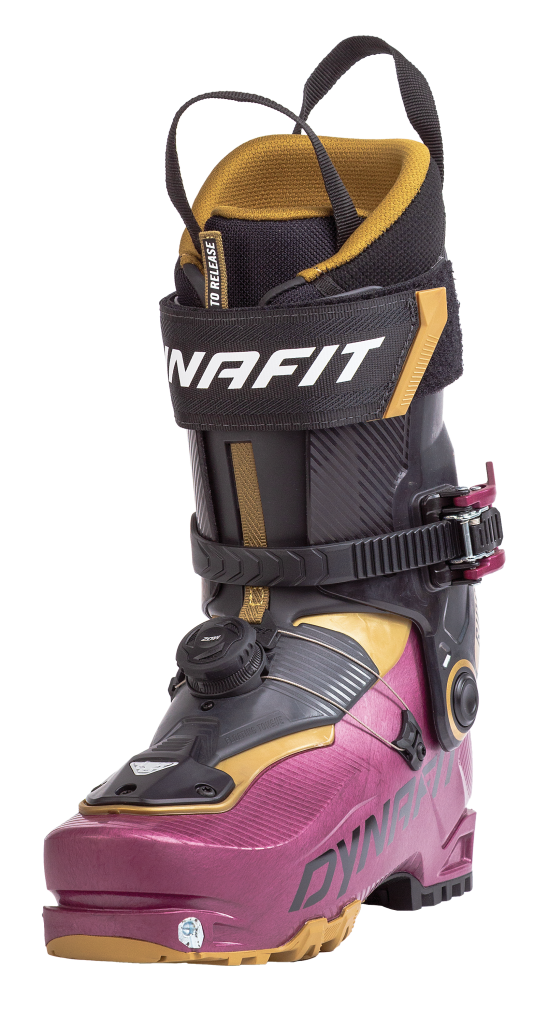
The svelte look of the Ridge W had women writing these off as a floppy skimo slipper, but according to one longtime tester, “Don’t let the lil’ purple bootie appearance fool you. Holy rippers!”
While the shell, spoiler and cuff are lightweight grilamid, the cuff is stiffened with glass fibers. “Definitely stiffer than the claimed 100 flex,” said a tester who took these for spring tours in the Tetons. Her claim was backed up by the 5/7 average score for lateral and fore/aft stiffness from the other 11 testers who got on the Ridge W, one of whom added, “A massive improvement to initiate boot to ski snow feel, and the less jerky fore/aft movement is a huge win for flex appeal.”
Depending on your definition of “buckle,” you could count up to three: a power strap, a ratchet strap at the bottom of the cuff and a Boa over the foot. “Boa cinch over the forefoot and single angled ankle ratchet strap work perfectly as a system to minimize play or movement,” said a thin-footed tester. Going from ski to walk mode was a breeze, thanks to the Hoji Lock System’s back lever loosening the entire cuff for a claimed 70-degree ROM. But these boots lost points when it was time to lock back in for the descent. “It takes some effort and finesse to push the lever back down,” said a tester who has perfected the technique over three generations of Hoji Lock boots. “But the unencumbered walk mode and consistent downhill performance make up for the transition woes.”
“Don’t let this boot fool you! It is a plug boot hiding in an AT shell. It can handle resort mank effortlessly while still offering AT abilities without being a complete wuss.” —Becca Friedlander

Get the 2026 Gear Guide
Published here are just some of the 144 best skis, splits, boots, bindings and outerwear from our 2026 Gear Guide. To check out the full range backcountry gear we reviewed, pick up a copy of the 2026 Gear Guide, available in print and PDF versions.
*Affiliate link disclaimer:
At Backcountry Magazine, we are committed to providing you with honest and informative gear coverage. To support our work and continue delivering quality content, we are including affiliate links in our reviews. Partnerships with retailers are separate from coverage, ensuring that our reviews remain unbiased. These links help us earn a small commission if you make a purchase through them, at no additional cost to you.








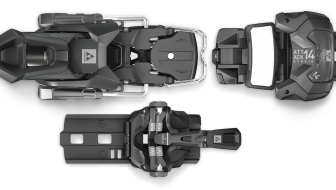

Related posts: